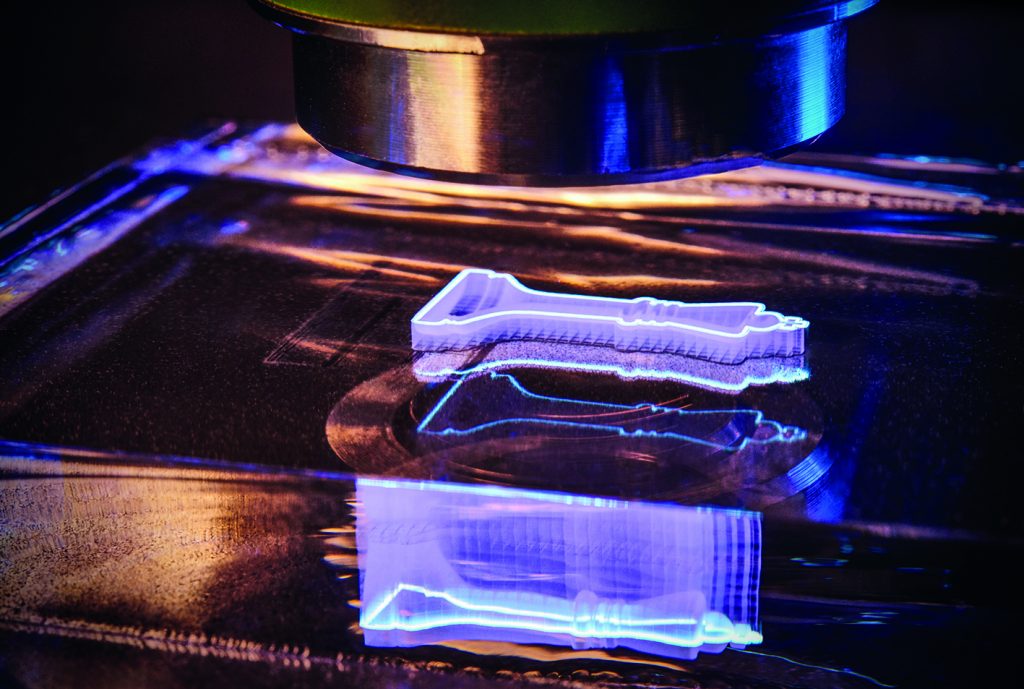Cutting glass can be a dangerous and difficult process – but with specially shaped, ultrashort laser pulses developed by the Fraunhofer Institute for Laser Technology ILT, it doesn’t have to be. It was smartphone displays, in fact, that made the scientists at Fraunhofer ILT wonder about how round shapes in tempered glass could be separated quickly and easily. With ultrashort pulse (USP) lasers, glass can be modified and broken along any contour without releasing any dust or residue.
Unlike other glass cutting techniques, the lasers do not scratch the surface of the glass, but instead generate small material stresses inside the material volume, which results in a clean edge when the material is separated. This requires a special intensity distribution within the laser beam, with a long beam waist and a steeply sloping intensity profile.
 Modern diffractive optical elements (DOE) can shape light into almost any shape. Thanks to their diffraction structure, the laser beam can be precisely adjusted, so special beam profiles or complex patterns can be generated from a single beam. The DOE can also distribute the energy of a single beam to a whole array of similar partial beams. Complex diffraction structures are a special feature of DOEs.
Modern diffractive optical elements (DOE) can shape light into almost any shape. Thanks to their diffraction structure, the laser beam can be precisely adjusted, so special beam profiles or complex patterns can be generated from a single beam. The DOE can also distribute the energy of a single beam to a whole array of similar partial beams. Complex diffraction structures are a special feature of DOEs.
Developing these optics begins at a computer, where scientists calculate tiny phase patterns, which produce the desired beam distribution. Using a programmable spatial light modulator, they test the calculated structures with pixel-based phase adjustments and analyze the generated beam with a microscope. After a few iterations, the optimal structures of the DOE are lithographically inscribed in glass. DOEs can also be used as pure glass optics with over 100 watt USP lasers. In addition to diffraction-based DOEs, refractive optical elements (ROE) are also frequently used for beamforming because they can refract beams at a power in the multi-hundred watt range.
DOEs and ROEs have high thermal stability and thus offer a great deal of benefit in increasing the productivity of USP laser systems. Scientists at Fraunhofer ILT have developed DOEs that form an array of up to 196 similar beams from one powerful USP laser beam. Even when individual beams are used for processing, however, these optical elements open up many possibilities. Specially shaped USP laser beams can structure surfaces, introduce stress into glass volumes or change the refractive index locally.
Scientists at Fraunhofer ILT, along with the Chair for Laser Technology LLT at RWTH Aachen University and industry partners, are looking into the extent to which USP laser beams can be shaped. Also participating in this research and development are TRUMPF and 4JET Technologies, working within the framework of the Digital Photonic Production DPP research campus, a funding initiative of the German Federal Ministry of Education and Research (BMBF).
The participants are specifically working on processing glass for head-up displays for the automotive industry. Experts in the “Femto DPP” program are producing micrometer-sized defects in the glass, which reflect LED light at a certain angle as it is needed for head-up displays. The laser used in the machining can also be used to generate predetermined breaking points, which are introduced in a controlled manner for subsequent rapid glass cutting. The processing is expected to be able to work on any curved glass panels in the future.
Femtoprint technology has a huge potential impact on industry. In optics, but also in electronics femtoprint and other nanoprinting technologies can be used to manufacture two and three-dimensional shapes at the nanoscale. These forms can be used for microfluidics or glass microdevices and take 3D printing to nanosized objects. By advancing laser processing at this scale Fraunhofer advances future 3D printing applications and help push 3D printing makeing things that are a billionth of a meter in size.
Discuss this and other 3D printing topics at 3DPrintBoard.com or share your thoughts below.
Subscribe to Our Email Newsletter
Stay up-to-date on all the latest news from the 3D printing industry and receive information and offers from third party vendors.
Print Services
Upload your 3D Models and get them printed quickly and efficiently.
You May Also Like
Reinventing Reindustrialization: Why NAVWAR Project Manager Spencer Koroly Invented a Made-in-America 3D Printer
It has become virtually impossible to regularly follow additive manufacturing (AM) industry news and not stumble across the term “defense industrial base” (DIB), a concept encompassing all the many diverse...
Inside The Barnes Global Advisors’ Vision for a Stronger AM Ecosystem
As additive manufacturing (AM) continues to revolutionize the industrial landscape, Pittsburgh-based consultancy The Barnes Global Advisors (TBGA) is helping shape what that future looks like. As the largest independent AM...
Ruggedized: How USMC Innovation Officer Matt Pine Navigates 3D Printing in the Military
Disclaimer: Matt Pine’s views are not the views of the Department of Defense nor the U.S. Marine Corps Throughout this decade thus far, the military’s adoption of additive manufacturing (AM)...
U.S. Congress Calls Out 3D Printing in Proposal for Commercial Reserve Manufacturing Network
Last week, the U.S. House of Representatives’ Appropriations Committee moved the FY 2026 defense bill forward to the House floor. Included in the legislation is a $131 million proposal for...



































